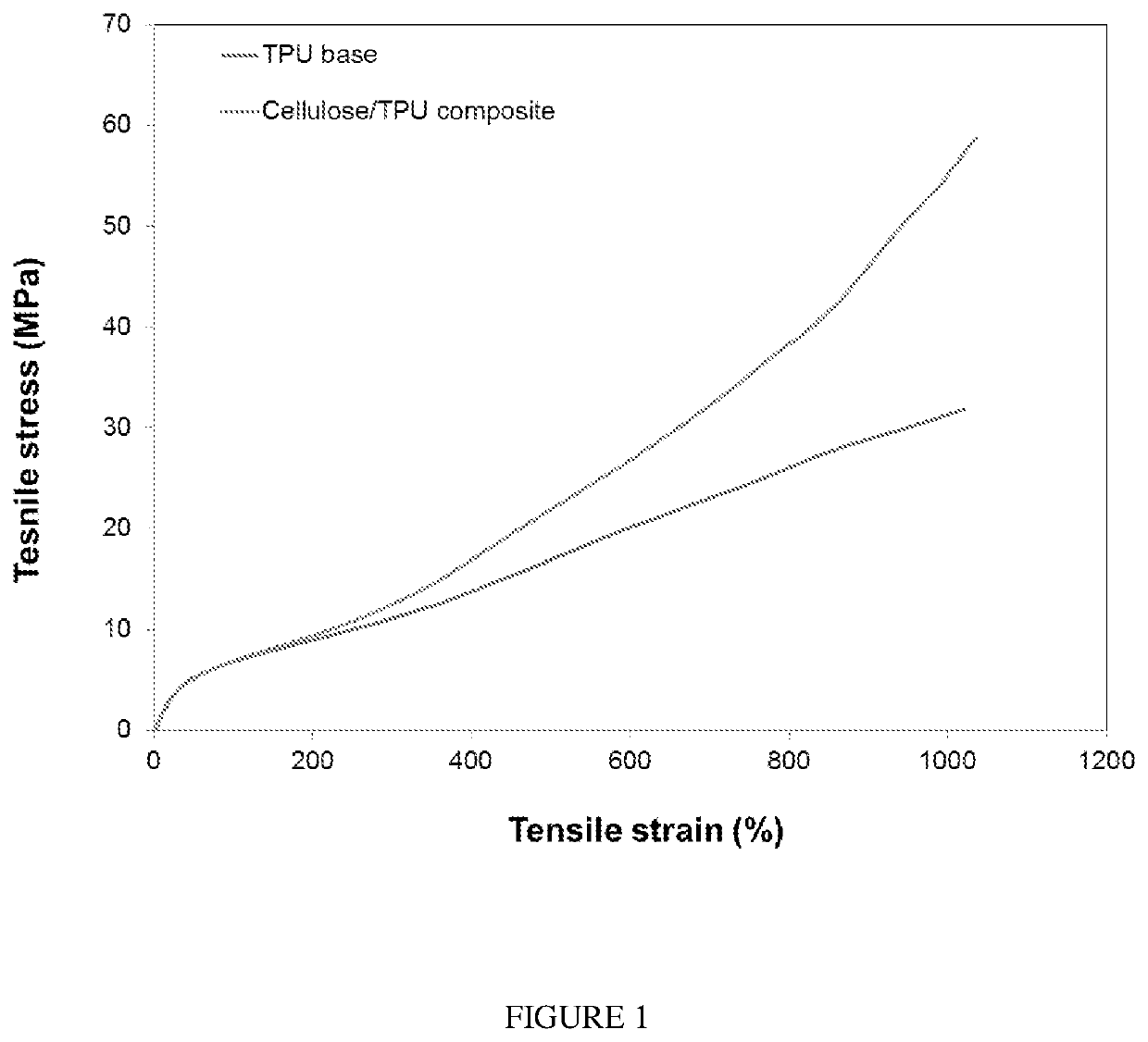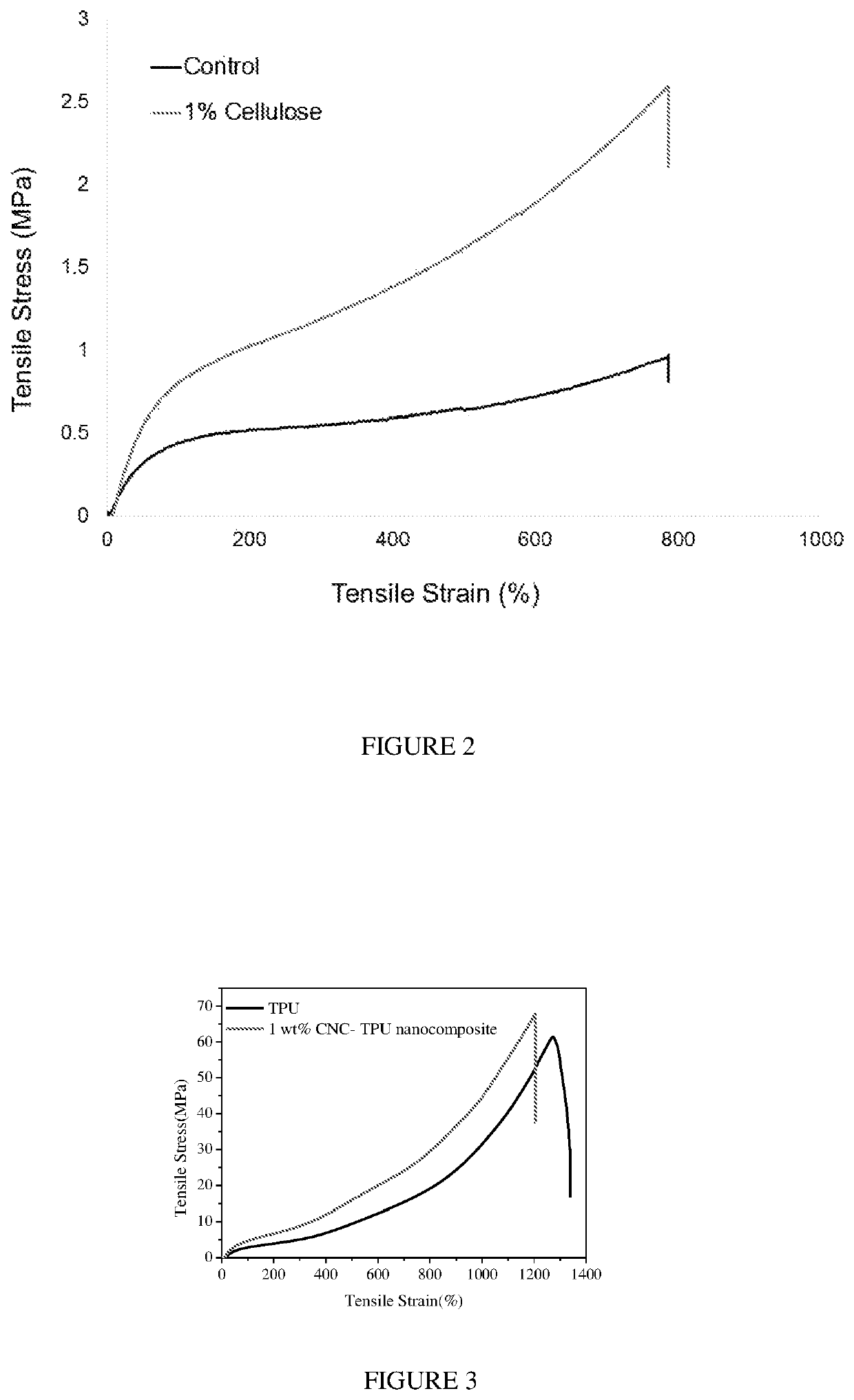Nanocomposite elastomers
a technology of elastomers and nano-composites, which is applied in the field of nano-composite elastomers, can solve the problems of poor compatibility of unmodified cellulose, poor dispersion of rubber, and use of unmodified cellulose as a reinforcing agent in rubber composites, and achieves the effects of reducing the number of pin holes, high strength, and building up the thickness of the elastomer membran
- Summary
- Abstract
- Description
- Claims
- Application Information
AI Technical Summary
Benefits of technology
Problems solved by technology
Method used
Image
Examples
example 1
[0077]Nanocomposites were prepared via reactive extrusion of a stable, very dry (Spinifex pulp using 40% (v / v) sulphuric acid for 3 hours at 45° C.).
[0078]
TABLE 1CNCHardPolyolcontentIsocyanatesegmentflow rateSamplePolyol type(%)indexratioStoichiometry(g / h)X1PTMEG1000—10.4411797.6X2PTMEG1000 + CNC0.46510.4411812.5X3PTMEG1000 + CNC0.46510.441.011812.5X4PTMEG1000 + CNC0.46510.441.021812.5X5PTMEG1000 + CNC0.46510.441.031812.5BDODieMDI flowflow rateTorquepressureSamplerate (g / h)(g / min)(%)(bar)X11157.6254.826-2715X21157.6254.82616X31169.1254.830-3121-22X41180.7254.839-4032-33X51192.3254.84337-38Young's ModulusTensile strainTensile stressWork at fractureSample(MPa)(go)(MPa)(MJ m-3)X114.5 ± 1.21124 ± 3141 ± 3237 ± 10X216.6 ± 0.31115 ± 4143 ± 1237 ± 6 X314.5 ± 0.41098 ± 21 48 ± 1.2257 ± 6 X414.5 ± 0.61023 ± 1154 ± 2250 ± 9 X5 16 ± 0.71012 ± 25 59 ± 3.2256 ± 14
[0079]Nanocellulose was present in an amount of 0.5% wt by weight of the composite (see X5 in table 1 above. X1 being the unfilled ...
example 2
[0083]In example 2, a composite material was produced from nanofibrillated cellulose and natural rubber latex (non-vulcanised). Nanocellulose was present in an amount of 1% wt of the composite.
[0084]The nanocellulose suspension (0.3-1%) was obtained via high-pressure homogenisation of spinifex pulp (T. Pungens) fibre. The nanocellulose used had a hemicellulose content of 42% w / w and a fibre diameter of 3.5 nm. Prior to mixing, the pre-vulcanized rubber latex (Gedeo concentrated mould making formula, Pebeo, France) was diluted to 20-50 mg / mL (on dry weight basis) depending on final composition (0.25, 0.5 and 1 wt. %). Both the suspensions were mixed together by magnetic stirring for 2-3 h, homogenised (using a hand held rotor-stator homogeniser) for 1-2 minutes and allowed to gently stir for another hour to degas. After degassing, the homogeneous mixture was cast onto Teflon petri-dishes, dried at 40° C. for 12 h-50 h (depending on nanocellulose content and volume) to obtain control ...
example 3
lose Reinforced Synthetic Rubber (Polyisoprene)
[0086]A composite of synthetic rubber (Cariflex IR401 polyisoprene latex in water) and nanocellulose (NFC with 42 wt. % hemicellulose content and 3-4 nm fibre diameter) was fabricated where the NFC was present at a loading of 0.53 wt. % (dry NFC mass) and rubber made up 99.47 wt. % (dry rubber mass) of the total nanocellulose plus rubber dry mass. The NFC was well dispersed as a 3.5% w / v aqueous dispersion and this was added to the Cariflex IR401 latex dispersion which had a solids content of 66% wt. Addition was done at room temperature and the mixture was stirred gently for 1 hour after addition. Sulfur (0.6% wt. of total solids mass), ZnO (0.2% wt. of total solids mass) and zinc diethyl dithiocarbamate (ZDEC, 0.5% wt.) were then added slowly to the dispersion to avoid shocking the latex. After all additions were completed, stirring was continued for 1 hour. After that stirring was stopped and stirred just once a day for 30 min. The l...
PUM
| Property | Measurement | Unit |
|---|---|---|
| diameter | aaaaa | aaaaa |
| diameter | aaaaa | aaaaa |
| length | aaaaa | aaaaa |
Abstract
Description
Claims
Application Information
 Login to View More
Login to View More - R&D
- Intellectual Property
- Life Sciences
- Materials
- Tech Scout
- Unparalleled Data Quality
- Higher Quality Content
- 60% Fewer Hallucinations
Browse by: Latest US Patents, China's latest patents, Technical Efficacy Thesaurus, Application Domain, Technology Topic, Popular Technical Reports.
© 2025 PatSnap. All rights reserved.Legal|Privacy policy|Modern Slavery Act Transparency Statement|Sitemap|About US| Contact US: help@patsnap.com


